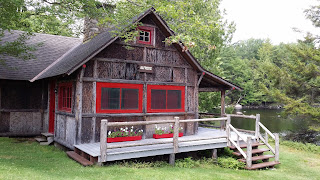Saturday
Sent birthday greetings to Bobbie, then headed off to Raquette Lake, still in the Adirondocks, for the 10 a.m. tour of the Vanderbilt Great Camp Sagamore which was only 18 miles away. So I thought it could easily be reached in 45 minutes. I barely made it in time on the white knuckle road which is so curvy that most of it is 40 mph or less, the last 4 miles on a gravel road full of ruts.

Upon arriving my first thought was that this couldn't be it. And it wasn't the main house of course, as we were brought in the back door. The Vanderbilt friends and family arrived via the lake from a railroad connection to see the best view upon approaching. The tour began in the Upper Complex, which housed the workers, with outbuildings being a schoolhouse for the worker's children, blacksmith shop, etc.
The first house we saw was a guest house which was used quite often by the young men of the family for frat parties on excursions from Yale. It was far enough removed from the main house as not to be a nuisance.
The porch was the scene of some pretty wild parties as evidenced from the amount of glass found in the creek below.
Many Arts and Crafts touches are seen in the twig work on the porch and other areas.
This closeup shows the bark which covers the outside of most of the main buildings and was used to give the rustic camp look. This bark was from a tree that was at least 200 years old judging by the deepness of the grooves.
The living room of this guest house is small and was probably crowded when inhabitants of the 4 bedrooms were all there together.
Rooms are available now for guests and one of the members of our tour was a guest in this building. She showed us her room, tiny two single beds and a fireplace. Very cozy.
Nearer the main house two smaller homes were built for the Vanderbilt children. When they came of age they could reside here independently of the large lodge.
William West Durant designed Sagamore in 1897. He also designed J.P. Morgan's Camp Uncas and Collis Huntington's Camp Pine Knot. Each is a National Historic Landmark today.
These camps served as a model for the National Park Service lodge buildings.
But these lavish properties were no more camps for the rich than the cottages at Newport were cottages. "Roughing it" meant something different to the wealthy businessmen of the Gilded Age.
There were at least 8 workers for each guest who stayed. They could hike the 20 acres of wildlife or fish or hunt or canoe around the lake.
America began vacationing in the Adirondacks in 1869 after a book by William Murray made the area famous. It was after the horrendous Civil War and people were looking for a place to go to escape the heat of the big city. By 1875 there were 200 hotels and camps here.
The gathering room of the main house is not that large as guests were expected to be out enjoying nature. None of the furniture is original but it is of the period. Furnishings were all sold when the house was given to the state of Vermont in 1954.
During the time it was a Vanderbilt retreat from 1901 to 1954 guests included artists, musicians, actors, and dignitaries. Including Charlie Chaplin who certainly got around.
The game building held regular Casino nights with the roulette table in this corner.
And in case you were bored with the other activities and have had enough of croquet, there is a bowling alley.
The state of Vermont took over Sagamore and it remains today the only one of the Great Camps to
Had been chatting with this pair, mother and son, who are guests here. They were just very interesting and I love the jaunty angle she wears her hat!
be open to the public and operating on a not for profit basis.















That's what our house on Marsha Way was lacking -- guest quarters for the children. It's all so clear now. And a bowling alley with roulette table. I don't recall those on property, either. :-)
ReplyDeleteI've never visited any of these Great Camps, but would love to! The term "cottage" surely takes on a whole different meaning!
ReplyDelete